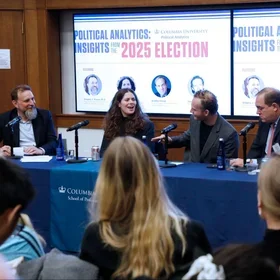The world of the human-capital management (HCM) leader is complex and dynamic and is often brimming with legal and ethical considerations. Below is a highlight of some key points relating to the federal Fair Labor Standards Act (FSLA) from Columbia University School of Professional Studies M.S. in Human Capital Management Foundations of Labor and Employment Law class.
This course leverages both synchronistic classroom-learning opportunities with asynchronistic online-discussion forums. These online forums empower students to continue applying related legal and ethical principles and concepts to complex, real-world case-study scenarios that require additional reflective thought in order to transfer and apply that which they gleaned from their in-person classroom experience.
As students begin to formulate mitigation strategies and longer-term organizational solutions in the context of real-world case studies, these online forums also serve to supplement student insights around:
- the intersection of a multitude of employment and labor laws and nuanced ethical dimensions that can be implicated in a single workplace-related case scenario and
- the preparation HCM leaders must undertake before embarking on discussions about potential legal matters with a variety of audiences, including organizational counsel, senior leaders, line managers, employees, union leaders and external-agency investigators.
Please keep in mind this blog is offered in an academic context and should not be relied upon as a substitute for specific advice from employer’s counsel about any situations occurring within a particular organization.
JOB-RELATED RECRUITMENT AND SELECTION CRITERIA
- It is strategically and legally sound to assure organizational leaders are basing recruitment and selection decisions on objective, job-related criteria.
- When this is accomplished, it serves the financial and ethical interests of the organization as well because potential legal claims that can drain resources are mitigated while helping to preserve reputational branding.
- Thus, having a clear understanding of the job-related knowledge, skills, and behavioral characteristics (that must be consistently demonstrated in order to deliver expected job results in the organizational-culture context) is key.
- Since human-capital management (HCM) leaders will not be subject-matter experts for all job categories within the organization, this necessitates a collaborative effort with hiring managers and, potentially, senior leaders depending upon the level of the job vacancy.
TO REFER OR NOT TO REFER?
- HCM leaders should be aware of the ramifications of recruiting and hiring primarily through an employee-referral program.
- While the concept of an employee-referral program is not inherently illegal, the disparate impact (unintentional discrimination) that can occur is problematic, especially if this is the primary recruitment vehicle for hiring.
- For example, let’s say the organization was recruiting to fill a scientist role and that role is currently filled almost exclusively by white men.
- Relying almost solely on employee referrals would more than likely lead to more white men that could lead to disparate impact on diverse female applicants and candidates of color.
- This is problematic in the context of any required or voluntary affirmative-action plan in place at the organization.
- Additionally, this approach can run afoul of anti-discrimination statutes including and not limited to Title VII and the ADEA and applicable state civil-rights employment laws.
YOU TRAVEL FROM WHERE?
- Sometimes line managers and others opine that a candidate “lives too far away” and will “likely arrive late, want to leave early and may not stay for the long term”.
- While this is possible, when thinking about what drives individuals to arrive early/on time, work their required schedules and exhibit normal retention interest, what is really being assessed is their core behaviors.
- Routinely arriving to work late can occur whether someone lives within a 20-minute commute of the organization or a 2-hour commute.
- What drives timeliness is the person’s individual behavior and commitment to meeting her/his/their employment obligations.
- For example, one person living within walking distance is perpetually late. Yet, another employee with a 2-12-hour commute (each way), including the crossing of a state line and involving car, bus, and train transportation, is always on time. In each case, core behaviors were at issue and not the length or type of commute.
- Depending upon where the work site is located, limiting the commute can exclude geographic areas that are within a reasonable commute that may contain a disproportionate number of minority candidates based on race, religion, etc.
- This seemingly neutral-on-its-face commute requirement could easily lead to disparate impact and potential legal liability for the employer.
- As with the employee-referral program, this type of limitation can negatively impact voluntary or required affirmative-action programs and related diversity goals.
- When all job notices/postings are clear about the location of the job vacancy, work schedule (days and hours), this enables the candidates to determine the feasibility of the commute within the parameters and tolerances of their specific needs and responsibilities.
THE “FRIENDS AND FAMILY” PLAN
- Similar to the concerns about employee-referral programs, seeking referrals from friends and family of existing employees may perpetuate discrimination through disparate impact.
- Another legal downfall to this approach is the potential conflicts-of-interest that may arise should family and friends be hired.
- Some employees may not call out bad behaviors/actions of their friends or family who have been hired.
- This can perpetuate a negative and toxic workplace culture that can lead to a number of organizational costs including and not limited to turnover of valued employees who seek a more ethical culture elsewhere, decreased morale and productivity, increased grievances, etc.
WHAT’S YOUR NUMBER?
- As with any pre-employment applicant testing, the information that is gleaned must relate to objective job-related criteria.
- Thus, the problem with administering IQ tests is that it may not be a valid predictor of job success.
- Additionally, some of these tests may be culturally biased in a way that would have a disparate impact on certain protected classes.
- Alternatively, some organizations incorporate validated (non-biased) cognitive-aptitude tests that are designed to assess job-related problem-solving abilities, critical-thinking skills, etc.
EFFICIENCY AT THE COST OF LEGAL COMPLIANCE
- While some might argue limiting candidate pools will help to streamline the time it takes to fill a position, it could come at great cost to diversity and with substantial legal exposure.
- The reasoning against this type of approach is similar to that discussed under employee-referral programs.
- What HCM leaders will want to do is to expand applicant pools in order to source the best and most diversified talent.
HOW STRONG ARE YOU?
- The “strategy” of requiring all hourly candidates to “be able to life and move up to 20 pounds” because most jobs require this is problematic under the federal Americans with Disabilities Act (ADA) and applicable state-ADA laws.
- Firstly, the HCM leader should be examining what are the essential functions of the specific job vacancy. Then, if lifting up to 20 pounds is included in the essential functions, candidates who can perform the essential functions with or without accommodation may not be discriminated against.
- Having a broad-based, non-job-specific “20-pound requirement” is potentially legally problematic.
- Certainly, HCM leaders will want to assure that the job descriptions upon which selection criteria is formulated is accurate, complete, and up-to-date, especially when determining the essential functions of the job role.
INTERPLAY WITH STATE AND/OR LOCAL LAWS
- As indicated above, HCM leaders will need to assess proposed recruitment and selection criteria in the context of federal laws, voluntary or required affirmative-action plans, and state/local laws to assure organizational actions are legally compliant.
UNION CONTRACTS
- Additionally, HCM leaders will want to assure that provisions relating to hiring, transfers, promotions, etc. included in any of its collective-bargaining agreements are met.
- In some union contracts, there might be specific job-posting notice requirements that speak to where and for how long a posting must be made.
- Additionally, some CBAs contain certain “service requirements” for promotional and/or transfer eligibility (i.e., at least one year of continuous service in the current role).
DOCUMENTATION AND TRAINING
- As with any business record, HCM leaders will want to assure there is a process in place that supports the proper documentation of the recruitment and selection process.
- Especially important is the information that is documented as a result of individual candidate interviews.
- The information included in recruitment and selection documentation should be objective, accurate, complete, non-editorial (i.e., “this was the worst candidate ever interviewed”, etc.) and job-related.
- Once a documentation system is formulated and before it is implemented, it is prudent to review it with organizational counsel to assure counsel finds it to be legally sound.
- Additionally, HCM leaders will want to assure there are processes in place that support up-to-date job descriptions and managerial practices that promote professional, job-related interviews and selection decisions that advance legal and ethical considerations as well as diversity goals.
ETHICAL CONSIDERATIONS
- Applicants are at a tremendous disadvantage because they do not have access to the behind-the-scenes deliberations that go into a selection decision.
- While an applicant who believes her/his/their treatment during the interview process may be discriminatory has potential legal recourse, the time and financial costs can be prohibitive.
- All the more reason HCM leaders need to drive a highly ethical and legally compliant recruitment and selection process.
ATTORNEY INVOLVEMENT
- The value of consulting with organizational counsel to assure all recruitment and selection policies and procedures comply with all applicable laws and contract requirements cannot be overstated.
- HCM leaders carry a significant responsibility and corresponding opportunity to drive ethically and legally sound strategies to help reduce the employer’s legal and reputational risk.



